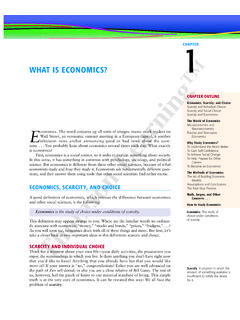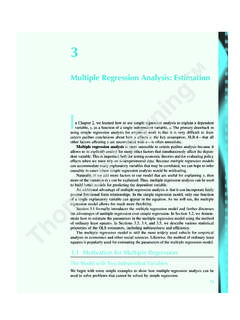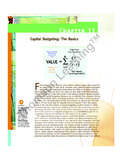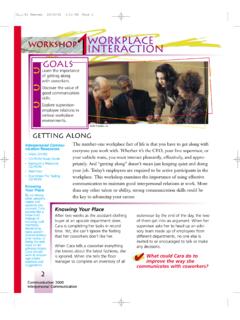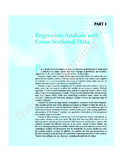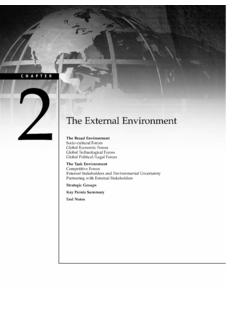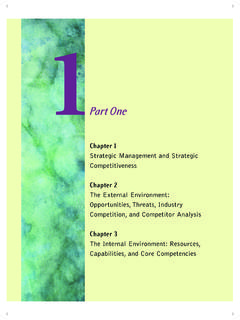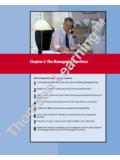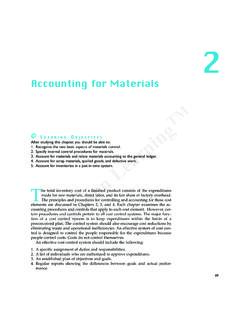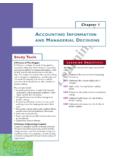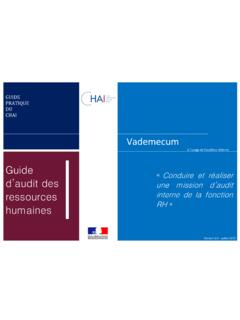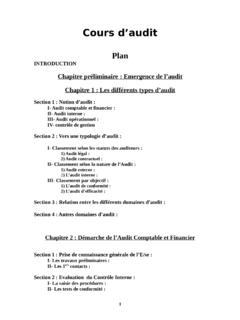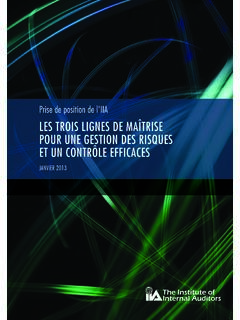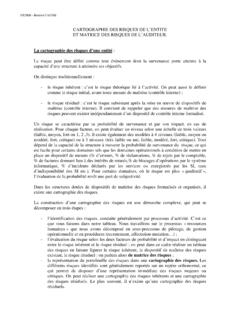Transcription of THE REVENUE CYCLE
1 4 James A. HallChapterAccounting Information Systems, 4th. REVENUE CycleStudy Notes Prepared by H. M. Savage South-Western Publishing Co., 2004 Page 4-1 CHAPTER 4 THE REVENUE CYCLEThe REVENUE CYCLE is the set of activities in a business which brings about the exchange ofgoods or services with customers for cash. Most business transactions are conducted on acredit basis. Cash is received after goods are shipped to the customer. Your book discussesthis as a two phase process: the physical phase in which goods or services are transferred tothe buyer; and the financial phase in which the cash is received from the buyer. The firstphase is handled by the sales order processing subsystem, the latter by the cash first section of the chapter provides an overview of the REVENUE CYCLE presented as amanual system.
2 The second section examines various ways to computerize this effort, fromtraditional data processing to process reengineering. The last section considersmicrocomputer systems and control objectives of this chapter are:!to recognize the fundamental tasks that must be performed in the REVENUE cycleregardless of the level of technology in place;!to be able to identify the functional departments involved in REVENUE CYCLE activitiesand to trace the flow of REVENUE transactions through the organization;!to be able to specify the documents, journals, and accounts that provide audit trails,promote the maintenance of historical records, support internal decision making, andsustain financial reporting;!to understand the risks associated with the REVENUE CYCLE and to recognize the controlsthat reduce these risks; and!
3 To be aware of the operational and control implications of technology used toautomate and reengineer the REVENUE CYCLE . 4 James A. HallChapterAccounting Information Systems, 4th. REVENUE CycleNotesStudy Notes Prepared by H. M. Savage South-Western Publishing Co., 2004 Page of REVENUE CYCLE ActivitiesThe data flow diagram presented in Fig. 4-1, on page 174,represents what must occur in the sales order processing partof the REVENUE CYCLE . Eight different steps, or processes, arerepresented in the DFD and discussed in the narrative. Useboth text and diagram to grasp what happens in each process. Note also the entities involved and the data stores or filesused. Regardless of how a particular business is organized, if it sellsto its customers on credit, all of these eight steps must occur.
4 This discussion focuses on the work to be done and therequired flows of data, but not the methods used to do ProceduresFig. 4-2, on page 176-7, is a document flowchart ofthe same system. [Document flow charts wereintroduced in Chapter 2. Go back and review thesymbols as presented in Fig. 2-17, on page 68.]Notice that the flowchart is divided vertically torepresent the various departments involved in salesorder processing. Some of the departments involvedare not accounting related. Many parts of a businessmust contribute to the generation of REVENUE ,including:!sales,!credit,!billin g,!warehouse,!shipping,!billing,!invento ry control,!accounts receivable, and!general of these departments exists to perform necessarytasks within the organization.
5 Now is the time toclarify for yourself the role of each department. Askyourself why there is a credit department, where it fitsin the organizational structure, what it does, and why. Ask these questions for all of the above functions, notjust the accounting-related following the narrative, make note of the variousdocuments prepared in the process, including whoprepares the documents, the number of copies ofeach, what is done to the various copies ( ,approval of the credit copy), and where the individualcopies end up. Pay special attention to the occasions 4 James A. HallChapterAccounting Information Systems, 4th. REVENUE CycleNotesStudy Notes Prepared by H. M. Savage South-Western Publishing Co., 2004 Page 4-3on which various items are reconciled.
6 Be sure youunderstand what items or numbers are beingreconciled and why. The book will show manysample documents in these transaction chapters. Ifyou work with some of these, they may look familiar. If not, now is a good time to learn about them. Mostbusinesses do not prepare documents for the fun of it. When information is collected on a form, it is for aspecific purpose. Examine the sample documentsclosely to be sure that you understand the purpose ofthe documents and what information appears on it,why, and why it moves through the organization as ReturnsAll sales are not final! And procedures must be inplace to handle sales returns. Various reasons canlead to returns from customers: incorrect goodsshipped, defected or damaged product, late delivery, 4-8, on page 185, is a flowchart of sales returnsprocedures.
7 Again, departments are separatedvertically. Recognize how many parts of theorganization are involved when a customer returnsgoods, and how well documented the effort must Receipts SystemBooking the order and shipping the goods to thecustomer are good starts but .. The cash receiptssystem is a very important part of the REVENUE CYCLE . It is also an extremely vulnerable part. Cash is veryliquid and has been known to walk away if not , an overview of the system is given in a dataflow diagram. Fig. 4-10, on page 188, shows theprocedures required to receive payment, updaterecords, and get the money to the bank. Follow thenarrative carefully. Pay attention to the parts of theorganization that are involved and what happens ineach. Fig.
8 4-11, on page 189, is the companiondocument CYCLE ControlsTable 4-1, on page 192, presents the six classes ofinternal control introduced in Chapter 3 with specificcontrol points for the two subsystems of the revenuecycle. The narrative is well done. Read it carefully. 4 James A. HallChapterAccounting Information Systems, 4th. REVENUE CycleNotesStudy Notes Prepared by H. M. Savage South-Western Publishing Co., 2004 Page 4-4 Transaction authorization must occur at many pointsin the REVENUE CYCLE to make sure that the transactionshould occur. As a result, a specific OK must begiven to sell on credit to new or repeat customers, topermit the return of goods for credit, and to recordpayments segregation of duties material is extremelyimportant.
9 No one person should have the ability, letalone the authority, to carry out a transaction frombeginning to end. The separation of authorization,recordkeeping, and custody of assets must bemaintained. This does not prevent fraud, but it doesmake collusion necessary. Many individuals whomight pull a scam on their own would not solicit thehelp of someone segregation of duties is conceptually valid,many firms are not able to separate all conflictingduties. The alternative to adequate separation ofduties is increased supervision. This works well inmany small businesses where an owner/manager ishighly involved in the day-to-day discussion of the accounting records, and therelated controls, is particularly important. You needto know how the records work.
10 Chapter 2introduced the basic accounting documents. Indiscussing control in the REVENUE CYCLE , specificattention is paid to aspects of the records that serve topreserve the audit trail. Here is another place to askyourself why things are done, what purpose is served,what problems are prevented. Pay attention to thedifferent files involved and what they is easy to think of the need to lock up valuablephysical assets. But it is just as important to securethe organization s records. Access controls refer toboth. And depending on the types of goods a firmhandles, unauthorized access to the accountingrecords may be a greater risk than access to thephysical of the good things about a manual system is thefrequency with which one part of the system checksup on another and can therefore catch errors.
